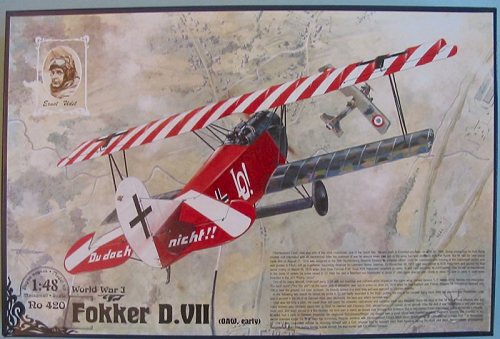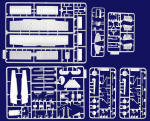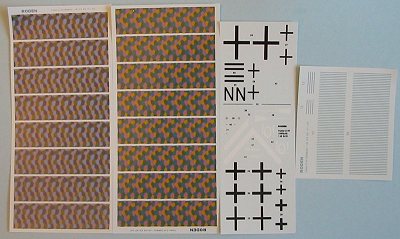
| KIT: | Roden 1/48 Fokker D.VII (OAW-early) |
| KIT #: | 420 |
| PRICE: | $19.96 MSRP ($17.96 at Squadron) |
| DECALS: | Three options |
| REVIEWER: | Tom Cleaver |
| NOTES: |

| HISTORY |
The Fokker D.VII had proven so superior to all other types at the 1918 Fighter Competition held at Johannistal in January 1918 that it was ordered into immediate mass production. Fokker did not have sufficient plant capacity to meet the demand, with the result that the Fliegertruppenamt decided that the aircraft would be produced by Albatros under license to Fokker. For Anthony Fokker, who had been in competition with Albatros throughout the war, it was a particularly satisfying outcome.
Albatros, which consistently exercised superior quality control in their factories, produced superior examples of the D.VII, and the best of all in terms of quality were those that came from the Ostdeutsche Albatros Werke (OAW) in Schneidemuhl, which had more production capacity than both the Fokker and original Albatros factories combined.. The first D.VIIs were very similar to the early Fokker-built D.VIIs, other than the OAW airplanes used 4-color lozenge fabric instead of the 5-color fabric used by Fokker. OAW-built D.VIIs began to appear with the leading Jastas in mid-May, 1918. Eventually, OAW would produce over 2,000 D.VIIs by the end of the war, about 55% of total D.VII production, maintaining their reputation for quality throughout even as the rest of the German industrial plant declined.
One of the first aces to receive the new fighter was Leutnant Ernst Udet, Jastafuehrer of Jasta 4, one of the units in Jagdgeschwader 1, known as the Richtofen “flying circus.” Udet had his airplane given the full “circus” treatment. While only one photograph exists of the aircraft - a shot of Udet standing directly in front of the rudder, with the photograph only showing the wings out to a point three or four feet from the fuselage - the wild “candy-stripe” of the upper wing and the personal insignia on the elevators, with “Du Doch Nicht!” (“but not you!”) as a “poke in the eye” to any Allied pilot can be seen. Unfortunately for Udet, the airplane lasted less than two weeks in combat once so painted. On June 29, 1918, he attacked a French Breguet XIV, whose gunner gave Udet the scare of his life when the beautiful D.VII caught fire and Udet was only just able to save his life with the then-new parachute. Udet’s ‘chute opened only 100 feet above No Man’s Land, and he dropped heavily into a shell hole, from which he was rescued by German infantrymen. Over the course of the next two months of combat against the British and French in the terrible summer of 1918, Udet brought his score to 62 before being wounded badly in his thigh and evacuated to a hospital in Germany where he spent the remaining days of the war. His score was second only to that of Manfred von Richtofen.
| THE KIT |
 If you have seen the previous Roden D.VIIs, you know pretty much what is in
the box. The kit is “fiddly” to build, but the result is the most accurate
D.VII model currently available. My friend Shane Weir has told me that if
you trim the lower wing so that it fits to the fuselage with the upper
surface horizontal, and do not deepen the locating holes for the wing
struts, that you can get the proper spacing between upper and lower wings,
something that drove me nuts with the first two of these I built. I also
strongly suggest that you attach the side cowling to the fuselage half
before further assembly to get correct fit, and only put the engine inside
without using the engine mount, in order to get correct assembly of the
entire model.
If you have seen the previous Roden D.VIIs, you know pretty much what is in
the box. The kit is “fiddly” to build, but the result is the most accurate
D.VII model currently available. My friend Shane Weir has told me that if
you trim the lower wing so that it fits to the fuselage with the upper
surface horizontal, and do not deepen the locating holes for the wing
struts, that you can get the proper spacing between upper and lower wings,
something that drove me nuts with the first two of these I built. I also
strongly suggest that you attach the side cowling to the fuselage half
before further assembly to get correct fit, and only put the engine inside
without using the engine mount, in order to get correct assembly of the
entire model.
 The kit includes
decals for Udet’s famous “candy-striper” and markings for a D.VII with
lozenge upper and lower wings flown by Lt. Hans Besser of Jasta 12, along
with an anonymous D.VII. Lozenge decal of the correct colors sufficient to
do the entire wing is provided, along with separate light blue rib tape.
The markings for Udet’s airplane show only the upper surface of the wing
painted in the candy-stripe, with the lower surface in lozenge. Numerous
modelers - yours truly included - have done this airplane with the whole
wing painted, and from the available photograph there is no way of
determining for certain which way is correct, but to me it does seem right
that only the upper surface would be painted unless the entire wing was
removed during the painting process; this was not usually the case with
airplanes painted at the unit level, so when I do this as Udet’s airplane I
will follow the instructions as the “best guess.”
The kit includes
decals for Udet’s famous “candy-striper” and markings for a D.VII with
lozenge upper and lower wings flown by Lt. Hans Besser of Jasta 12, along
with an anonymous D.VII. Lozenge decal of the correct colors sufficient to
do the entire wing is provided, along with separate light blue rib tape.
The markings for Udet’s airplane show only the upper surface of the wing
painted in the candy-stripe, with the lower surface in lozenge. Numerous
modelers - yours truly included - have done this airplane with the whole
wing painted, and from the available photograph there is no way of
determining for certain which way is correct, but to me it does seem right
that only the upper surface would be painted unless the entire wing was
removed during the painting process; this was not usually the case with
airplanes painted at the unit level, so when I do this as Udet’s airplane I
will follow the instructions as the “best guess.”
| CONCLUSIONS |
The D.VII is certainly the easiest biplane for a modeler new to World War I modeling to attempt, since there is no rigging other than that between the gear legs and the control wires to the elevator and rudder. While this kit is fiddly, anyone with experience in doing a “fiddly” model should have no difficulty creating a very nice-looking model.
Review Kit courtesy of Roden
You can find this kit and many others at

If you would like your product reviewed fairly and quickly by a site that has over 250,000 visitors a month, please contact me or see other details in the Note to Contributors.